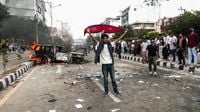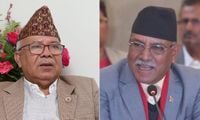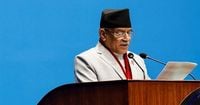In the waning days of October and the first days of November 2025, a familiar yet urgent refrain echoed through the streets of Nepal and reverberated across the Global South: young people, many of them still in their teens, demanded a future that felt increasingly out of reach. The recent Gen Z-led protests in Nepal, which erupted in early September, are the latest chapter in a wave of youth-driven uprisings sweeping countries from Chile to Sri Lanka, Colombia to India. These movements, while sparked by local grievances, share deep underlying currents—frustration with entrenched political elites, economic precarity, and a sense that the systems meant to serve them are instead failing them.
According to historian and journalist Vijay Prashad, writing for Tricontinental: Institute for Social Research on November 3, 2025, these uprisings can’t be understood as isolated incidents. Instead, they form a global pattern, particularly pronounced in the Global South, where the median age hovers around 25—and in some countries, much lower. Prashad points to the Chilean uprising that began with a 30-peso metro fare hike but quickly grew into a mass rejection of three decades of neoliberal austerity. That movement, led by high school students born between 2001 and 2005, inspired slogans like, “They took so much from us that they even took away our fear.”
But Chile was hardly alone. Prashad notes that Generation Z—often reduced to a marketing label in Western media—has been at the forefront of protests worldwide. The 2012 mass mobilizations in Delhi, India, against gang rape, the 2018 March for Our Lives campaign against gun violence in the United States, and the Fridays for Future climate movement initiated by Greta Thunberg all share a generational DNA. More recently, the 2021 national strike in Colombia, Sri Lanka’s 2022 Aragalaya struggle, and Nepal’s own political upheaval this year have seen young people channeling their outrage into collective action.
What’s driving this surge? Prashad lays out seven theses that help explain the roots of Gen Z’s discontent. First and foremost is demographics: the Global South is young. In Niger, the median age is just 15.3; in Mali, 15.5; Uganda and Angola, 16.5; and Zambia, 17.5. These youthful societies are grappling with harsh debt-austerity policies, climate disasters, and seemingly endless wars. The result is a generation that feels both the burden of history and the weight of a future slipping away.
Unemployment is another critical factor. Prashad highlights how neoliberal reforms have hollowed out the state’s capacity to provide jobs, leaving educated youth—often the first in their families to attend university—struggling with structural unemployment or a mismatch between their skills and available work. “Gen Z is the most educated generation in history, yet it is also the most indebted and underemployed. This contradiction between aspiration and precarity produces great resentment,” he writes.
The pressure to migrate for work is also a powerful force. In Nepal, protestors have chanted, “We want jobs in Nepal. We don’t want to have to migrate for work.” Globally, there are around 168 million migrant workers, whose remittances—$857 billion in 2023—often surpass foreign direct investment in their home countries. Yet for many, the reality of migration brings shame, dislocation, and the painful knowledge that their skills and education may go unrecognized abroad.
Rural distress, driven by the expansion of agribusiness and mining at the expense of smallholder farmers, is pushing young people from the countryside into cities—and sometimes into protest movements. Climate change, too, is not an abstraction for Gen Z. In rural areas, melting glaciers, droughts, and floods are daily realities, exacerbated by global supply chains hungry for resources like lithium and cobalt. Prashad contends that for many young people, the climate crisis is “directly linked to their inability to build a present, let alone a future.”
Perhaps most damning is the sense that establishment politics have nothing to offer. In Nepal, as in many other countries, young protesters see constitutions that fail to reflect reality, unaccountable judiciaries, and political parties paralyzed by international debt-austerity consensus. Instead, new political voices—often social media influencers with little party experience—rise to fill the vacuum, channeling anti-politics and middle-class resentment.
The rise of informal work and the gig economy has further fragmented society. Traditional sources of solidarity, like trade unions, have weakened, and the internet has become the main conduit for political ideas and organizing. Prashad cautions, however, that social media is a tool, not the root cause of these protests. “It is tempting but inaccurate to suggest that social media itself is a driving force behind this wave of protests,” he argues. “Social media is a communication tool which has enabled a diffusion of sentiments and tactics, but it is not the condition for these sentiments.”
Against this backdrop, Nepal’s political establishment has responded in a way that, for many, feels painfully out of touch. On November 2, 2025, an editorial in the Kathmandu Post took aim at the country’s leftist parties, which have responded to the Gen Z protests by consolidating power through mergers. The CPN (Maoist Centre), the CPN (Unified Socialist), and other fringe communist outfits have announced a merger, but the same old faces—Pushpa Kamal Dahal, Madhav Kumar Nepal, and other veteran leaders—are poised to retain control.
“The youngsters who took to the streets during the Gen Z uprising, as well as intellectuals, members of the civil society, and the media—all are saying with one voice that there can be a meaningful change in Nepali politics only if the old set of leaders call it quits and hand over reins to the next generation,” the Kathmandu Post editorial asserts. The piece argues that these political maneuvers are little more than a charade, failing to address the genuine aspirations of the young protesters. “If these forces still cannot catch the public sentiment, they will sink along with their ageing leaders.”
This critique resonates far beyond Nepal’s borders. Prashad points out that many Gen Z-led protests in the Global South are urban and often co-opted by entrenched interests, seldom addressing the deeper structural crises facing their societies. Yet he insists these movements cannot be dismissed. Their frequency is likely to increase as demographic, economic, and environmental pressures mount.
For those invested in the future of leftist and progressive politics, the challenge is clear: articulate the grievances of Gen Z into a transformative agenda that demands a fairer share of social resources and invests in meaningful change. As the streets of Kathmandu, Santiago, and Colombo attest, the young are not waiting for permission—they are demanding to be heard.
The world is watching to see if the old guard will finally step aside, making way for a new generation of leaders who can turn protest into progress and resentment into renewal.






